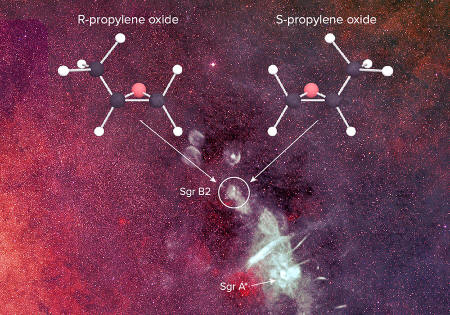|
June 20, 2016 from QuantaMagazine Website
by N.E. Kassim, Naval
Research Laboratory, Sloan Digital Sky Survey
a chiral molecule, propylene oxide, in a star-forming region
called Sagittarius B2.
This property, known as chirality, is a major aspect of life on Earth. The sugars that form the backbone of our DNA are all right-handed. The molecular building blocks that make our proteins are left-handed.
As we noted in "New Twist Found in the Story of Life's Start," a 2014 article on the origins of chirality, the question of how this extreme chirality came into being is a major mystery in the origins of life.
In a new discovery reported (Discovery of the Interstellar Chiral Molecule Propylene Oxide) last week in Science, researchers identified the first complex organic chiral molecule in interstellar space.
The molecule, propylene oxide, was found floating in a cloud of dust and gas known as Sagittarius B2 and is one of the most structurally intricate chemicals found in space to date.
Scientists think that collisions between particles swirling through interstellar dust clouds can create simple organic molecules. The ice that forms on grains of interstellar dust within these clouds can then link these molecules into increasingly complex structures.
The molecules emit telltale signatures that scientists can detect using radio telescopes. The new findings emerged from the Prebiotic Interstellar Molecular Survey, a decade-long project at the National Science Foundation's Green Bank Telescope.
Scientists hope the findings will help them figure out how chiral molecules are formed in space, which could in turn illuminate the origins of chirality here on Earth.
Yet many scientists are skeptical that purely physical phenomena, such as the arrival of circularly polarized light coming from a supernova, would be enough to explain the extreme chirality of life.
In our 2014 story, we spoke with two researchers who had doubts about such theories.
Marcelo Gleiser, a theoretical physicist at Dartmouth College, noted that the purely physical theories describing the origins of life's chirality create,
But these physical biases are too small to account for life's extreme chirality, he said.
Gerald Joyce, a biochemist at the Scripps Research Institute in La Jolla, Calif., echoed that sentiment, saying that the effect of these physical forces, such as polarized light or radioactive decay, would be lost in the noise of chemical reactions.
David Kaplan explores the leading theories for the origin of life on our planet.
David Kaplan, Petr Stepanek and Ryan Griffin for Quanta Magazine; music by Kai Engel
|


